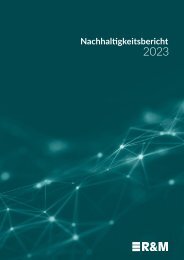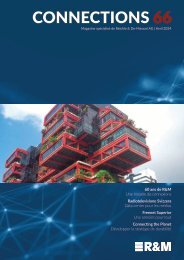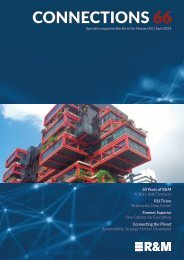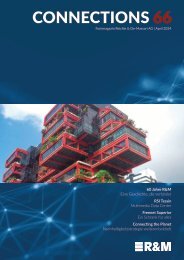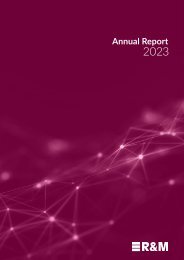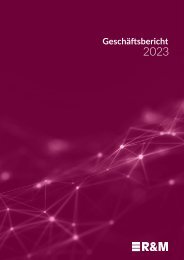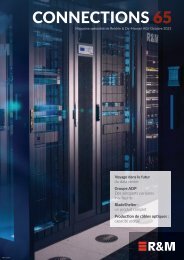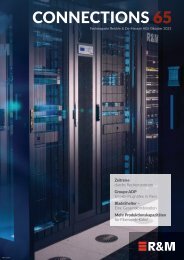CONNECTIONS_55-e
R&M customer magazine, Connectivity, Cabling, Fiber Optica, Copper
R&M customer magazine, Connectivity, Cabling, Fiber Optica, Copper
Create successful ePaper yourself
Turn your PDF publications into a flip-book with our unique Google optimized e-Paper software.
050.6658<br />
one another and linked in to a supervisory<br />
building master control system.<br />
The need for intelligent, networked building<br />
automation is increasing all the time driven,<br />
among other things, by the demand for<br />
increased convenience, security, efficient<br />
use and cost control. Other factors, such as<br />
saving energy and minimizing CO 2<br />
emissions,<br />
add to these demands.<br />
Everything over IP?<br />
To date the many modules of building automation<br />
have tended to work with their own<br />
protocols and transmission technologies.<br />
Over the last 30 years, several independent<br />
standards have become established on the<br />
market, such as BACnet, LON, EIB, KNX,<br />
DALI and SMI. With the help of special<br />
gateways, these systems can be linked to one<br />
another and the superordinate IT. In recent<br />
years, more focus was placed on the idea of<br />
communicating using a single protocol: the<br />
Internet Protocol (IP). Based on Ethernet<br />
network technology with its standardized<br />
interfaces, the IP enables a surprising number<br />
of new, efficient applications – not just the<br />
World Wide Web.<br />
And that is why the IEEE further developed<br />
the Ethernet protocol systematically to ensure<br />
it could also be used for building automation.<br />
From today’s standpoint – in the era of<br />
digitalization, the cloud and the Internet of<br />
Things – this consolidation would be a logical<br />
step. The result would be more intelligent<br />
buildings with standardized, affordable Ethernet<br />
connectivity and uniform IP addresses<br />
for every building technology module.<br />
Such intelligent buildings have no problem<br />
exchanging information between the<br />
systems. They could be controlled remotely<br />
over LAN and the Internet. People could talk<br />
to buildings using a virtual assistant. Due to<br />
the better exchange of information between<br />
the individual parts, buildings could save<br />
significant amounts of energy and resources.<br />
University surveys have shown that operating<br />
expenses in buildings could be reduced by up<br />
to 40 % in this way.<br />
Building automation today and tomorrow<br />
Today<br />
Building automation works independently from the data network<br />
technology. It is used to monitor, control, regulate and optimize systems<br />
and building technology. The components (sensors, actuators, devices) are<br />
usually networked using independent bus systems and protocols. Building<br />
automation and data networks are connected to each other using complex<br />
interfaces (gateways).<br />
Tomorrow<br />
Building automation migrates to IP/Ethernet and communicates via the<br />
standard IP protocol. Manufacturer-independent network technology<br />
connects the individual components. This consolidated IP infrastructure<br />
simplifies planning, installation, maintenance and operation. Component<br />
costs are reduced due to scaling effects.<br />
Management building technology Management network Smart building manager<br />
Building<br />
automation<br />
IT server IT server<br />
MANAGEMENT<br />
IP IP IP<br />
SPS<br />
IT switch<br />
FLOOR LEVEL<br />
Switch<br />
IP/radio<br />
HVAC<br />
KNX gateway<br />
Light<br />
DALI gateway<br />
Shading<br />
SMI gateway<br />
KNX DALI SMI bus<br />
ROOM LEVEL<br />
Smart<br />
rooms<br />
Digital<br />
Ceiling<br />
Work<br />
area<br />
Copper Copper Copper<br />
050.6660<br />
<strong>CONNECTIONS</strong> 10I2018–<strong>55</strong><br />
5









